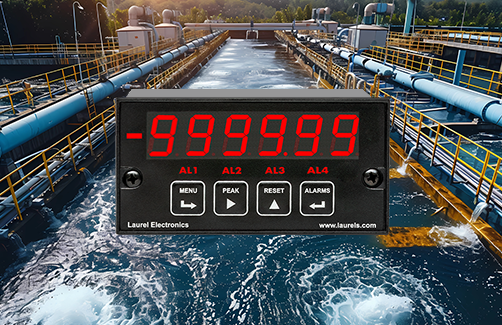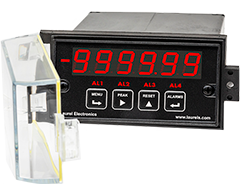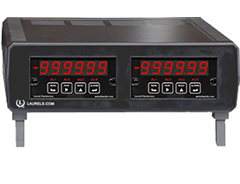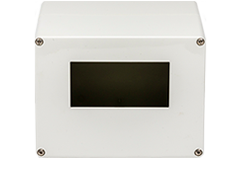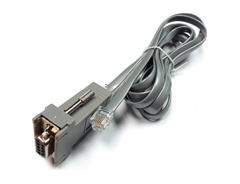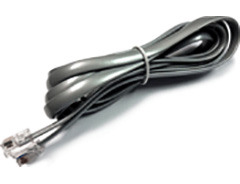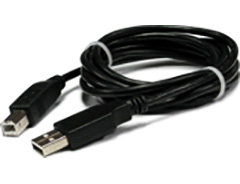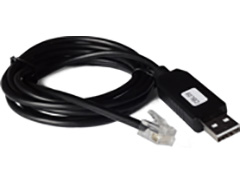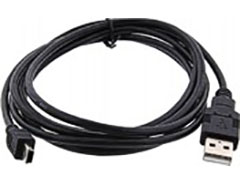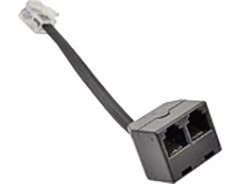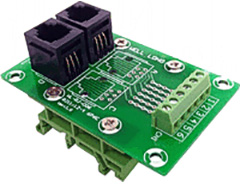Features
- 6-digit display of rate or totalized rate, totalizer flow meter, field scalable
- High accuracy: ±0.005% of span ±1 count
- 0-1 mA, 4-20 mA or 0-10 V analog signal to a frequency of 10 kHz to 110 kHz
- Converts signal input to a scaled rate or totalized rate
- Selectable square root for differential flow
- Output accuracy maintained for narrow or wide spans
- Extracts square root from differential pressure flow transducers & flow totalizer
- All input ranges are user selectable and factory calibrated
- Digital span adjust from 0 to ±999,999, zero adjust from -999,999 to +999,999
- Front panel scalable to ±999,999 for use with current shunts
- 1/8 DIN size with bright red or green 0.56" (14.2mm), high LED digits
- Transducer excitation output, 5, 10, 12, or 24 Vdc (isolated)
- Power 85-264 Vac / 90-300 Vdc or 10-48 Vdc / 12-32 Vac (isolated)
- Operating temperature from -40°C to 70°C (-40°F to 158°F)
- Wide choice of Plug-in-Play options:
- 2 or 4 relays, mechanical or solid state, for alarm or control (isolated)
- 1 or 2 Analog output, 4-20 mA, 0-20 mA, 0-10V, or -10V to +10V (isolated)
- Communications: Ethernet, WiFi, USB, RS232, RS485 (isolated)
- Extended DPM allows up to 180 data points for custom curve linearization, time based on rate, batch control
The Laureate™ 1/8 DIN Digital Panel Meter is a six-digit display of rate or total at the push of a front panel key.
A Laureate with the Standard counter main board and a VF voltage-to-frequency signal conditioner board can be scaled to display rate or totalized rate to six digits for 0-1 mA, 4-20 mA or 0-10V analog process signals to a frequency of 10 kHz to 110 kHz. Special input ranges are available from the factory. For example, the display can be scaled to show flow rate in gallons/minute or liters/sec, or to show volume in gallons or liters from the 0-10V output of a flow transducer. Or the display can be scaled to display power consumption in kilowatts or total utilized energy in kilowatt-hours based on the 0-1 mA output of a watt transducer.- Square root extraction is selectable and can be applied to rate or total. This makes the VF Laureate ideal for use with differential pressure flow meters, which have a squared output. Totalized volume is based on linearized rate.
- Accuracy is one of the highest for any digital panel meter: ±0.005% of span ±1 count.
Laureate Digital Panel Meters are easily programmed with Laurel’s free Instrument Setup Software, downloadable from our website and compatible with Windows PCs, requiring a data interface board for setup.
All signal conditioner board ranges are factory-calibrated, with calibration factors for each range securely stored in an onboard EEPROM. These factors can be scaled via software to accommodate external shunts, enabling field replacement of signal conditioner boards without necessitating recalibration of the associated digital panel meter. For optimal accuracy, factory recalibration is recommended annually. All Laurel Electronics instruments undergo factory calibration using the industry-leading Fluke calibrators, which are recalibrated yearly and certified traceable to national standards, ensuring the highest level of precision and reliability.
Extended DPM Counter Version
- Batch control based on linearized total. A Laureate VF meter with the Extended counter main board can totalize linearized flow from an analog rate signal, and also count up to a preset value, or count down to zero from a preset value for batch control. Operation as a batch controller requires the dual-relay output board option. One of the relays is dedicated to ON/OFF batch control. The other relay is available to slow down rate near the setpoint or to provide another alarm or control function based on rate or total.
- Custom Curve Linearization. For custom curve linearization, up to 180 data points can be input into a spreadsheet or text file by the user. The computer then calculates spline-fit segments, which are downloaded into the meter via RS232. The Extended VF meter can linearize and display analog inputs based on a custom curve, for instance to read out the volume of an irregularly shaped tank based on level or pressure, or to linearize a nonlinear transducer. Custom-linearized rates can also be totalized and be used for batch control.
- Time Based on Rate. The Extended VF meter can display a time inversely proportional to measured rate, such as the time that it will take a conveyor to traverse an oven. As the rate of the conveyor is increased, the displayed baking time is decreased.
Principles of V-to-F Operation
The V-to-F signal conditioner board converts the full-scale 0-1 mA, 4-20 mA or 0-10 V analog signal to a frequency of 10 kHz to 110 kHz. This frequency is determined by measuring period over a selected gate time (from 10 ms to 200 s) and taking the inverse of period. Selecting a short gate time provides a much higher update rate than conventional counting-type frequency meters. At the lowest frequency of 10 kHz and the minimum gate time of 10 ms, the meter is capable of 25 updates per second. Scaling to rate in engineering units and totalizing are done mathematically. Totals are calculated as the product of rate and time in seconds regardless of the selected gate time. Totals are stored in nonvolatile memory in case of power loss.
High Resolution Display
The display of rate or total may be scaled to ±999,999. The two least-significant digits may be set to display zero with rounding or be active digits. Noise in rate readings can be reduced by selecting a longer gate time. In addition, an adaptive digital filter can reduce variations due to noise while rapidly responding to actual changes in signal level.
- An unfiltered selection provides true peak and valley readings and aids in control applications.
- A batch average filter selection averages each 16 conversions.
- An adaptive moving average filter selection provides a choice of 8 time constants from 80 ms to 9.6 seconds. When a significant change in signal level occurs, the filter adapts by briefly switching to the shortest time to follow the change, then reverts back to its selected time constant. An Auto setting selects the time constant selection based on signal noise.
Peak and valley values are automatically captured. These may be displayed via a front panel pushbutton command or control signal at the rear connector, or be transmitted as serial data.
Two rear panel control Inputs (CMOS/TTL levels, logic 0 = tied to digital ground, logic 1 = open) or dry contacts that can be set to control / activate 14 meter commands.
An (isolated) 5, 10, 12, or 24 Vdc excitation output is standard to power transducers or two-wire transmitters. Ratiometric operation, which automatically compensates for changes in the applied excitation, is jumper selectable for applications, such as bridges, where the signal to be measured is proportional to the excitation level.
Modular Design for Maximum Flexibility at Minimum Cost
All boards are isolated from meter and power grounds. Optional Plug-in-Play boards for communications and control include Ethernet, WiFi, serial communication boards, dual or quad relay boards, and an analog output board. Laureates may be powered from 85-264 Vac or optionally from 12-32 Vac or 10-48 Vdc. The display is available with bright red or green 0.56" (14.2mm) high LED digits. The 1/8 DIN case meets NEMA 4X (IP65) specifications from the front when panel mounted. Any setup functions and front panel keys can be locked out for simplified usage and security. A built-in 5, 10, 12, or 24 Vdc excitation supply can power transducers, eliminating the need for an external power supply. All power and signal connections are via UL / VDE / CSA rated screw clamp plugs.
The Laureate™ Series features modular design with up to 7 isolated plug-in boards, applicable to all Laureate 1/8 DIN Digital Panel Meters.

Modular Hardware
The design of the Laureate™ Series is modular for maximum flexibility at minimum cost. All boards are isolated from meter and power grounds. The base configuration for a panel meter or counter consists of a main module (with computer and plug-in display boards), a power supply board, and a signal conditioner board. Optional plug-in-play boards include an isolated setpoint controller board, an isolated analog output board, and an isolated digital interface board. Modular design and a choice of plug-in options allow the Laureate to be customized for a broad range of applications from simple monitoring to control and computer interface. There can be up to five plug-in boards in a 1/8 DIN Laureate.

Connecting Laureate Digital Panel Meters to a Local Area Network (LAN)
Up to 30 Laureate Digital Panel Meters and/or LT Transmitters can be configured for RS485 and daisy-chained to an LT Transmitter using Laurel’s High Speed Ethernet-to-RS485 converter board for seamless LAN integration. Alternatively, Laurel LTE series Ethernet transmitters can connect directly to a LAN via an Ethernet cable. Setup for both configurations is streamlined using Laurel’s free Instrument Setup Software, which simplifies node discovery and transmitter configuration.
Flexible Communication Options for Digital Panel Meters
Laureate Digital Panel Meters can be equipped with Laurel communication boards to support various interfaces and protocols. These include serial interfaces with ASCII or Modbus RTU protocols, and Ethernet interfaces with web access, ASCII, or Modbus TCP/IP protocols, ensuring versatile connectivity for your commercial applications.

| Display | |
|---|---|
| Readout | 6 LED digits, 7-segment, 14.2 mm (.56") |
| Color | Red or green LED |
| Range | -999999 to +999999 |
| Indicators | Four LED lamps |
| Inputs | |
| Standard signal levels | 4-20 mA, 0-1 mA, 0-10V (jumper selectable) |
| Input resistance | 50Ω at 4-20 mA, 1.00 kΩ at 0-1 mA, 1.01 MΩ at 0-10V |
| Other signal levels | Consult factory |
| Recalibration: All ranges are calibrated at the factory. Recalibration is recommended every 12 months. | |
| Conversion | |
| Frequency Technique | Inverse period |
| Update Rate | Gate time + 30 ms (max) |
| Gate Time | Selectable 10 ms to 199.99 s |
| Accuracy | |
| Span tempco | ±0.003% reading/°C |
| Zero tempco | ±0.003% FS/°C |
| Accuracy at 25°C | ±0.01% FS ± 1 count |
| Power Supply Boards (one required) | |
| Voltage, standard | 85-264 Vac or 90-300 Vdc |
| Voltage, optional | 12-32 Vac or 10-48 Vdc |
| Frequency | DC or 47-63 Hz |
| Power consumption (typical, base meter) | 1.2W @ 120 Vac, 1.5W @ 240 Vac, 1.3W @ 10 Vdc, 1.4W @ 20 Vdc, 1.55W @ 30 Vdc, 1.8W @ 40 Vdc, 2.15W @ 48 Vdc |
| Power Isolation | 250V rms working, 2.3 kV rms per 1 min test |
| Excitation Output (standard) | |
| 5 Vdc | 5 Vdc ± 5%, 100 mA (jumper selectable) |
| 10 Vdc | 10 Vdc ± 5%, 120 mA (jumper selectable) |
| 12 Vdc | 12 Vdc ± 5%, 100 mA (jumper selectable) |
| 24 Vdc | 24 Vdc ± 5%, 50 mA (jumper selectable) |
| Output Isolation | 50 Vdc from signal ground |
| Analog Output Boards (one optional) | |
| Output levels | 4-20 mA, 0-20 mA, 0-10V, -10 to +10V (single-output option) |
| 4-20 mA, 0-20 mA, 0-10V (dual-output option) | |
| Current compliance | 2 mA at 10V ( > 5 kΩ load) |
| Voltage compliance | 12V at 20 mA (< 600 Ω load) |
| Scaling | Zero and full scale adjustable from -99999 to +99999 |
| Resolution | 16 bits (0.0015% of full scale) |
| Isolation | 250V rms working, 2.3 kV rms per 1 min test |
| (dual analog outputs share the same ground) | |
| Relay Output Boards (one required for batch control) | |
| Dual magnetic relays | 2 Form C, 8A max, 440Vac or 125Vdc max, 2500VA or 300W |
| Quad magnetic relays | 4 Form A (NO), 8A max, 440Vac or 125Vdc max, 2500VA or 300W |
| Dual solid state relays | 2 Form A (NO), AC or DC, 0V - 400V, 120Ma, 35Ohms (max at On-State) |
| Quad solid state relays | 4 Form A (NO), AC or DC, 0V - 400V, 120Ma, 35Ohms (max at On-State) |
| Relay commons | Isolated commons for dual relays or each pair of quad relays |
| Relay isolation | 250V rms working, 2.3 kV rms per 1 minute test |
| Relay latching modes | Latching or non-latching |
| Relay active modes | Active on or off, active high or low |
| Hysteresis modes | QA passband mode, split hysteresis, span hysteresis |
| Communication Boards (one optional) | |
| Board selections | RS232, RS485 with dual RJ11 connectors, RS485 with dual RJ45 connectors, USB, Ethernet, USB-to-RS485 gateway, Ethernet-to-RS485 gateway, WiFi with built-in antenna plus USB & RS485, WiFi with external antenna plus USB & RS485 |
| Protocols | Laurel Custom ASCII (serial), Modbus RTU (serial), Modbus TCP (Ethernet or WiFi) |
| Digital addresses | 247 (Modbus), 31 (Laurel ASCII), |
| Isolation | 250V rms working, 2.3 kV rms per 1 min test |
| Environmental | |
| Operating temperature | -40°C to 70°C (-40°F to 158°F) |
| Storage temperature. | -40°C to 85°C (-40°F to 185°F) |
| Relative humidity | 95% at 40°C, non-condensing |
| Protection | NEMA-4X (IP-65) when panel mounted |
| Electrical Connections | |
 |
|
| Mechanical | |
| Enclosure | 1/8 DIN, high impact plastic, UL 94V-0, color: black |
| Mounting | 1/8 DIN panel cutout required: 3.622" x 1.772" (92 mm x 45 mm). |
| Dimensions | 4.68" x 2.45" x 5.64" (119 mm x 62 mm x 143 mm) (W x H x D) |
| Maximum panel thickness | 4.5 mm (0.18") |
| Tightening Torque - Connectors | Screw terminal connectors: 5 lb-in (0.56 Nm) |
| Tightening Torque - Pawls | Digital Panel Meter Case Pawls: 5 lb-in (0.56 Nm) |
| Weight of base meter | 210 g (7.4 oz) typical (DPM, counter, timer, 6-digit remote display) |
| Weight of option boards | 30 g (1.0 oz) typical per board (analog output, relay output, communications) |
| General | |
| Programming Methods | Four front panel buttons or via Laurel's free Instrument Setup Software, which runs on a PC under MS Windows. |
| Security | Lockout options include using the front panel buttons, the free Instrument Setup Software, or a hardware jumper. |
| Warranty | 3 years parts & labor |
| Recalibration: All ranges are calibrated at the factory. Recalibration is recommended every 12 months. | |
Free Instrument Setup Software for Series 2 Laureates
Free Downloadable Windows-based Instrument Setup (IS) software (Data Interface Board Required) for use with our programmable Digital Panel Meters, Scale Meters, Counters, Timers, Remote Displays, and Transmitters, are an easy method to set up Laureate 1/8 DIN digital panel meters, counters, timers, remote displays, and DIN-rail transmitters, as explained in the Instrument Setup Software Manual. Laureate 1/8 DIN instruments can also be set up from the front panel, as explained in their respective Owners Manuals. Instrument Setup software is of benefit whether or not the PC is connected to the instrument.
- When the PC is connected to the instrument, Instrument Setup software can retrieve the setup file from the instrument or open a default setup file or previously saved setup file from disk View Setup, then provides graphical user interface (GUI) screens with pull-down menus applicable to input, display, scaling, filtering, alarms, communications, analog output, and front panel lockouts. Fields that are not applicable to the instrument as configured are either left out or grayed out. Clicking on any item will bring up a detailed Help screen for that item. After editing, the setup file can be downloaded, uploaded to the instrument, or saved to a disk. The same setup file can then be downloaded into multiple instruments.
- When the PC is not connected to the instrument, the above GUI screens can be used to set up a virtual instrument. The setup file can then be saved to disk. Switching toView Menu then brings up a screen with the required front panel programming steps. This view can be printed out for use at the instrument site and to serve as a hard copy record.
Download Free Instrument Setup Software
Installation
Set User Account Control (UAC) of MS Windows to "Never notifiy me" so that Instrument Setup Software can create directories. The UAC change screen can be reached as follows:
- Under Windows 7, click on the Windows Start button in the lower left of the desktop and enter "UAC" in the search field.
- Under Windows 8, navigate to Control Panel, then to the "User Accounts and Family Safety" section, and click on "Change User Account Control Settings."
- Under Windows 10, click on the Windows Start button in the lower left of the desktop, then on "Settings", and enter "UAC" in the search field.
- Reboot your computer for the changed UAC setting to take effect.

RJ11-to-DB9 cable with rear view of DB9 connector to PC

RS232 cable, meter to PC, P/N CBL01
Laureate 1/8 DIN Laureate instruments must be equipped with a serial communications board and be connected to the computer via a serial communications cable. The connection can be via RS232, RS485, USB or Ethernet. Following setup, the serial communications board may be removed from the instrument if desired. The wiring of the RS232 cable is illustrated above with end views of the two connectors.
Laureate LT Series transmitters come standard with a 3-wire serial interface, which can be jumpered for RS232 or RS485.
Laureate LTE Series transmitters come standard with an Ethernet interface.
Meter Setup Screens
Click on any of the reduced screens below for a full-size screen view, then click on the Back button of your browser to return to this page. The screens examples below are for a fully-loaded Series 2 Digital Panel Meter (DPM), which is connected to the PC via RS232. If the meter is a Series 1 meter (pre-2007), this is sensed by the software, and somewhat different screens are brought up. Please see Series 1 setup screens.











Meter Setup Utilities




From the Main Menu, click on Readings if your PC is connected to the meter. A pull-down menu then offers three choices: List, Plot and Graph.
- List presents the latest readings in a 20-row by 10-column table. Press Pause at any time to freeze the display. This is one method to capture peak readings.
- Plot generates a plot of readings vs. time in seconds. It effectively turns the DPM-PC combination into a printing digital oscilloscope.

- Graph generates a histogram where the horizontal axis is the reading and the vertical axis is the number of occurrences of readings. The display continually resizes itself as the number of readings increases.



Laureate™ 1/8 DIN Case For Laureate Digital Panel Meters, Counters, Timers & Remote Displays
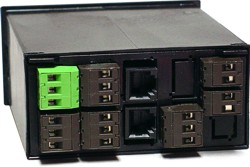
Key Features
- Meets 1/8 DIN Standard.
- Installs from front of panel.
- Short depth behind the panel: only 4" (102 mm) plus connectors.
- Understated 0.157" (4 mm) thick bezel.
- Meets NEMA 4X (IP-65) for high-pressure wawshdon when panel mounted.
- Screw clamps connectors meet VDE / IEC / UL / CSA safety standards.
- Rugged GE Lexan® housing material.
- Safety certified per EN 61010-1.
Dimensions
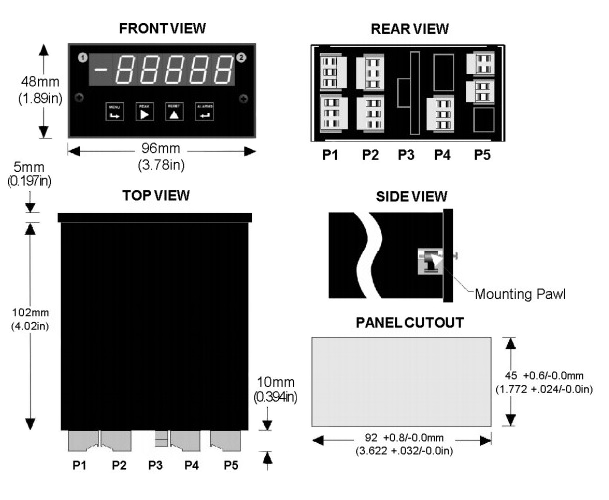
Maximum panel thickness: 4.5 mm (0.18")
Weight of base meter: 210 g (7.4 oz) typical (DPM, counter, timer, 6-digit remote display)
Weight of option boards: 30 g (1.0 oz) typical per board (analog output, relay output, communications)
Tightening Torque - Connectors: Screw terminal connectors: 5 lb-in (0.56 Nm)
Tightening Torque - Pawls: Digital Panel Meter Case Pawls: 5 lb-in (0.56 Nm)
Dimensioned CAD assembly drawings in EPRT, STEP, x_t. dwg, pdf file formats: Laureate-meter-case.zip (zipping prevents browser from opening CAD files as text files).
Panel Mounting
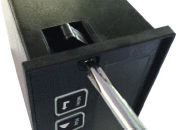 Slide the meter into a 45 x 92 mm 1/8 DIN panel cutout. Ensure that the provided gasket is in place between the front of the panel and the back of the meter bezel.
The meter is secured by two pawls, each held by a screw, as illustrated. Turning each screw counterclockwise extends the pawl outward from the case and behind the panel. Turning each screw clockwise further tightens it against the panel to secure the meter.
Slide the meter into a 45 x 92 mm 1/8 DIN panel cutout. Ensure that the provided gasket is in place between the front of the panel and the back of the meter bezel.
The meter is secured by two pawls, each held by a screw, as illustrated. Turning each screw counterclockwise extends the pawl outward from the case and behind the panel. Turning each screw clockwise further tightens it against the panel to secure the meter.
Turning each screw counterclockwise loosens the pawl and retracts it into its well. This position allows installed meter to be removed from their panel, or new meters to be installed in a panel. Do not remove the screws from their pawls. Doing so would cause the screw and pawl to fall off and likely get lost. Do not overtighten so as not to damage the plastic parts.
| Flow from a Differential Pressure Transducer | |
|---|---|
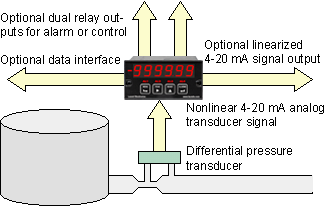 |
An ideal application for the Standard Laureate VF meter: readout of flow based on the 4-20 mA analog signal from a differential pressure transducer. Options include dual relays for alarm or control, isolated analog output to turn the meter into a transmitter, and RS232/485 data communications.s |
| Up- or Down-Counting Batch Controller | |
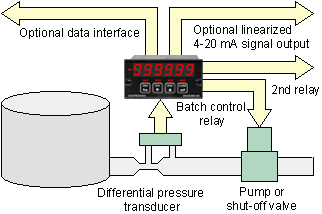 |
An ideal application for the Extended Laureate VF meter: up- or down-counting batch controller. The dual-relay card is required. One relay is dedicated to batch control, the other relay is available to alarm the rate or total. The signal input can be linear or nonlinear. The display can be toggled between rate and total. |
| Volume of an Irregularly-Shaped Tank | |
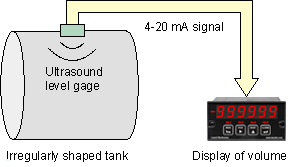 |
The Extended Laureate VF meter can linearize analog signals for display and alarm using custom curve linearization with multiple nonlinear segments. As illustrated, tank level is measured by an ultrasound detector, which transmits a 4-20 mA signal. This signal is then converted to a highly accurate volume reading. Linearized readings can also be totalized. |
| Process Time from an Analog Rate Signal | |
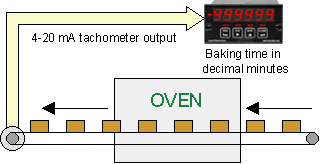 |
A unique application of the Extended Laureate VF meter is displaying process time based on the 4-20 mA or 0-10 V signal from a rate meter. In this example, a tachometer transmits the speed of a conveyer belt through an oven. The meter displays baking time in the oven using the mathematical relationship time = distance / speed. |
IPC
Splashproof Cover
CLB01
RS232 Cable for Meters
CLB02
USB-to-RS232 Adapter Cable
CBL04
RS232 Cable for LT Transmitters
CLB05
USB Data Cable for Meters
CLB06
USB-to-RS485 Adapter Cable
CLB07
USB Programming & Data Cable
CLB08
RS485 Splitter Cable
BKBD
RS485 RJ11 Terminal Block Adapter
What is a Digital Panel Meter for 6-Digit Analog Input Totalizer and Process Meter?
A digital panel meter for 6-digit analog input totalizer and process meter is a precision instrument designed to measure, display, and totalize analog signals, such as 4-20 mA, 0-10 V, or other process inputs, while providing high-resolution 6-digit readouts. These meters are essential in industrial, manufacturing, and process control applications where accurate monitoring and totalization of process variables, such as flow, pressure, or level, are critical. By processing analog signals into clear digital displays and cumulative totals, digital panel meters ensure reliable data for process optimization, inventory tracking, and system diagnostics.
Unlike basic analog meters, these digital panel meters offer high precision, programmable features, and advanced totalization capabilities, making them ideal for applications requiring detailed process monitoring and cumulative data analysis. The 6-digit display provides enhanced resolution for precise measurements and large totalized values, supporting complex tasks like batch control and production monitoring.
Understanding the Digital Panel Meter for 6-Digit Analog Input Totalizer and Process Meter
Digital panel meters for 6-digit analog input totalizer and process meter applications are typically built to the 1/8 DIN standard, fitting compactly into panel cutouts (approximately 92 mm x 45 mm). This compact size ensures compatibility with control panels while optimizing space, making them suitable for industrial control rooms, production lines, or equipment with limited space.
These meters are designed to process analog signals from sensors like flow meters, pressure transducers, or level sensors, measuring instantaneous process values (e.g., flow rate) and totalizing them over time (e.g., total volume). The 6-digit display allows for high-resolution readouts, accommodating large cumulative totals or precise process measurements. They feature bright LED or LCD displays, user-friendly interfaces, and communication interfaces like RS-485 or Modbus for integration with automation systems. Advanced features, such as signal scaling, filtering, and programmable totalization, ensure accurate and stable performance in demanding environments.
How Does a Digital Panel Meter for 6-Digit Analog Input Totalizer and Process Meter Work?
A digital panel meter processes analog input signals to measure process variables and totalize values, displaying results with high precision. Below is a detailed breakdown of its operation:
- Signal Acquisition:
The meter receives an analog signal, such as 4-20 mA or 0-10 V, from a sensor like a flow meter or pressure transducer, representing a process variable like flow rate or level. - Signal Conditioning:
The input signal is conditioned through amplification, filtering, or linearization to remove noise and ensure compatibility with the meter’s circuitry, critical for accurate measurements in noisy industrial settings. - Analog-to-Digital Conversion:
An Analog-to-Digital Converter (ADC) transforms the conditioned signal into a digital format. High-resolution ADCs enable precise measurements, supporting the 6-digit display’s accuracy. - Processing and Totalization:
The digital signal is processed by the meter’s microcontroller, which calculates instantaneous process values (e.g., flow rate in liters/min) and integrates them over time to compute cumulative totals (e.g., total liters). Scaling factors convert raw signals into engineering units. - Display:
The processed values (instantaneous or totalized) are displayed on a 6-digit digital screen, offering high resolution for precise readouts and large totals. The display can alternate between process values and totals or show both simultaneously with dual-display models. - Output and Integration:
The meter may provide outputs like 4-20 mA analog signals, relay contacts for alarms or batch control, or digital communication (e.g., Ethernet, USB) for integration with PLCs, SCADA systems, or data loggers. - Calibration and Configuration:
Users can calibrate the meter for specific analog inputs and configure settings like scaling factors, totalizer reset, or alarm thresholds to suit application needs.
Key Features of Digital Panel Meters for 6-Digit Analog Input Totalizer and Process Meter
Digital panel meters for 6-digit analog input totalizer and process meter applications include features that enhance performance and usability:
- 6-Digit Display: High-resolution display supports precise process measurements and large cumulative totals, ideal for detailed monitoring.
- High Accuracy: Precise ADCs and signal processing ensure reliable measurements for analog inputs, even in dynamic conditions.
- Totalization Capabilities: Integrates process signals over time to compute cumulative totals, supporting applications like batching or inventory tracking.
- Customizable Displays: Multi-color LEDs, bar graphs, or large-digit displays ensure readability in various lighting conditions.
- Programmable Alarms and Control: Setpoints for process values or totals trigger alerts or control external devices, such as pumps or valves.
- Communication Options: Protocols like Modbus or Profibus enable integration with industrial automation systems.
- Rugged Design: IP65-rated front panels resist dust and moisture, suitable for harsh industrial environments.
Applications of Digital Panel Meters for 6-Digit Analog Input Totalizer and Process Meter
Digital panel meters are widely used for analog input totalization and process monitoring in various applications. Key uses include:
- Flow Measurement and Totalization:
In fluid systems, DPMs measure flow rates from analog signals (e.g., 4-20 mA from flow meters) and totalize volumes for inventory or billing purposes. - Batch Control:
In manufacturing, digital panel meters totalize material inputs and trigger actions (e.g., valve closure) when preset totals are reached, ensuring precise batching. - Process Monitoring:
In industrial systems, DPMs monitor process variables like pressure, level, or temperature, providing real-time data for quality control and system optimization. - Inventory Management:
In storage systems, digital panel meters totalize material inputs or outputs (e.g., liquid volumes in tanks), supporting accurate inventory tracking. - Energy Consumption Monitoring:
In energy systems, DPMs measure and totalize power or energy usage from analog signals, aiding in efficiency analysis and cost management.
Where Are Digital Panel Meters for 6-Digit Analog Input Totalizer and Process Meter Used?
Digital panel meters (DPMs) are essential in industries requiring precise analog input totalization and process monitoring. With support for 4-20 mA, 0-10 V, or other analog signals and a compact 1/8 DIN design, these meters provide reliable solutions. Below are detailed use cases across key sectors:
- Water and Wastewater Treatment:
In treatment plants, digital panel meters measure flow rates and totalize water or chemical volumes from analog flow meter signals, ensuring accurate dosing and regulatory compliance. - Industrial Manufacturing:
In production lines, DPMs monitor and totalize process variables like material flow or pressure, supporting quality control. For example, in a chemical plant, they totalize additive volumes for precise mixing. - Oil and Gas Industry:
In pipelines or refineries, digital panel meters measure and totalize flow rates from analog sensors, tracking oil or gas volumes for inventory management or leak detection. - Food and Beverage Processing:
In filling or bottling lines, DPMs totalize liquid volumes from flow meters and monitor fill levels, ensuring consistent product quality and regulatory compliance. - Chemical and Pharmaceutical Manufacturing:
In chemical reactors, digital panel meters totalize material inputs from analog sensors, supporting precise batch control and meeting strict regulatory standards. - Energy and Power Generation:
In power plants, DPMs measure and totalize energy usage or fluid flows from analog signals, optimizing efficiency and supporting maintenance planning. - HVAC and Building Management:
In commercial buildings, digital panel meters monitor and totalize flow rates in heating or cooling systems, optimizing energy usage and ensuring system performance.
Benefits of Using Digital Panel Meters for 6-Digit Analog Input Totalizer and Process Meter
Digital panel meters offer numerous advantages for analog input totalization and process monitoring:
- High Resolution: 6-digit displays provide precise readouts and support large cumulative totals, ideal for detailed monitoring.
- High Accuracy: Precise ADCs ensure reliable measurements for analog process signals, even in dynamic conditions.
- Totalization Capabilities: Integrates signals over time for accurate cumulative totals, supporting batching and inventory applications.
- Compact Design: The 1/8 DIN size fits seamlessly into control panels, ideal for space-constrained setups.
- Versatility: Support for multiple analog input types and programmable settings accommodates diverse applications.
- System Integration: Communication interfaces enable connection to automation systems, enhancing data logging and process control.
- Durability: Built to withstand industrial conditions, including dust, moisture, and temperature fluctuations.
Choosing the Right Digital Panel Meter for 6-Digit Analog Input Totalizer and Process Meter
When selecting a digital panel meter for 6-digit analog input totalizer and process meter applications, consider these factors:
- Input Compatibility: Ensure the meter supports the analog signal types (e.g., 4-20 mA, 0-10 V) and ranges for your application.
- Accuracy Specifications: Verify the meter’s accuracy and resolution for process measurements and totalization.
- Totalization Features: Check for programmable totalizer functions, such as reset options or scaling, to meet application needs.
- Environmental Durability: Choose a meter with appropriate IP ratings for dust, water, or temperature resistance in industrial settings.
- Output Requirements: Determine if you need analog outputs, relays, or digital communication for integration with other systems.
- Display and Usability: Opt for a 6-digit display that’s readable in your environment and controls that are easy to configure.
Conclusion
Digital panel meters for 6-digit analog input totalizer and process meter applications, particularly 1/8 DIN models, are vital for precise monitoring and totalization in industries like manufacturing, water treatment, and chemical processing. Their high-resolution displays, accurate processing, and compact design make them ideal for complex process monitoring and cumulative data tracking. By delivering reliable data and integrating seamlessly with control systems, digital panel meters enhance process efficiency, ensure quality, and support system performance across diverse analog input applications.
Less Information.








